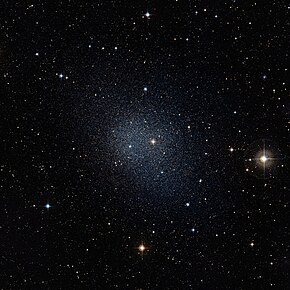| Fornax Dwarf Spheroidal | |
|---|---|
 The Fornax dwarf galaxy | |
| Observation data (J2000 epoch) | |
| Constellation | Fornax |
| Right ascension | 02h 39m 59.3s[1] |
| Declination | −34° 26′ 57″[1] |
| Redshift | 53 ± 9 km/s[1] |
| Distance | 466 ± 10 kly (143 ± 3 kpc)[2] |
| Apparent magnitude (V) | 9.3[1] |
| Characteristics | |
| Type | dE0[1] |
| Apparent size (V) | 17.0′ × 12.6′[1] |
| Notable features | has 6 globular clusters |
| Other designations | |
| Fornax dSph,[3] Fornax Dwarf Elliptical,[3] Fornax Dwarf Galaxy,[3] Fornax dE,[3] PGC 10074 / 10093,[1] ESO 356-4 | |
Preview warning: Page using Template:Infobox galaxy with unknown parameter "image_size"
The Fornax Dwarf Spheroidal (formerly known as the Fornax System) is a dwarf elliptical galaxy in the constellation Fornax that was discovered in 1938 by Harlow Shapley. He discovered it while he was in South Africa on photographic plates taken by the 24 inch (61 cm) Bruce refractor at Boyden Observatory, shortly after he discovered the Sculptor Dwarf Galaxy.[4]
The galaxy is a satellite of the Milky Way and contains six globular clusters, an unusually high number for its size;[5] the largest, NGC 1049, was discovered before the galaxy itself. The galaxy is also receding from the Milky Way at 53 km/s. It mostly contains population II stars, but also has populations of young and intermediate age.[2]
- ^ a b c d e f g "NASA/IPAC Extragalactic Database". Results for Fornax Dwarf Spheroidal. Retrieved 2006-11-29.
- ^ a b Oakes, Elias K.; Hoyt, Taylor J.; Freedman, Wendy L.; Madore, Barry F.; Tran, Quang H.; Cerny, William; Beaton, Rachael L.; Seibert, Mark (2022). "Distances to Local Group Galaxies via Population II, Stellar Distance Indicators. II. The Fornax Dwarf Spheroidal". The Astrophysical Journal. 929 (2): 116. arXiv:2204.09699. Bibcode:2022ApJ...929..116O. doi:10.3847/1538-4357/ac5b07. S2CID 248260222.
- ^ a b c d "NAME Fornax Dwarf Spheroidal". SIMBAD. Centre de données astronomiques de Strasbourg. Retrieved 2006-11-29.
- ^ Shapley H (1938). "Two Stellar Systems of a New Kind". Nature. 142 (3598): 715–6. Bibcode:1938Natur.142..715S. doi:10.1038/142715b0. S2CID 4071472.
- ^ Cite error: The named reference
Pacewas invoked but never defined (see the help page).